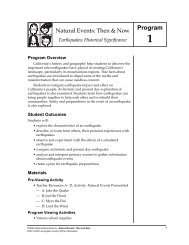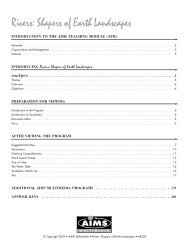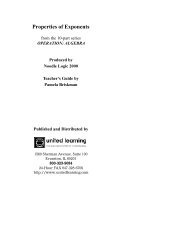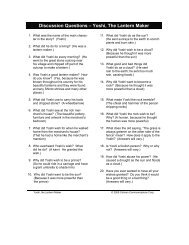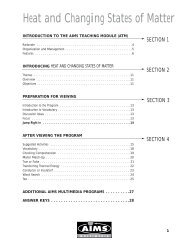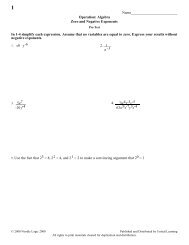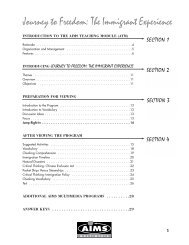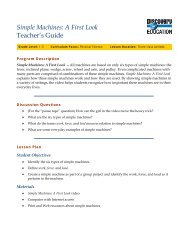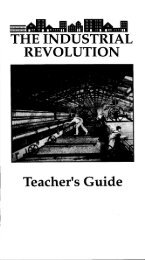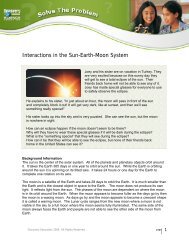THE TEEN FILES: The Truth About Violence
THE TEEN FILES: The Truth About Violence
THE TEEN FILES: The Truth About Violence
Create successful ePaper yourself
Turn your PDF publications into a flip-book with our unique Google optimized e-Paper software.
<strong>THE</strong> <strong>TEEN</strong> <strong>FILES</strong>: <strong>The</strong> <strong>Truth</strong> <strong>About</strong> <strong>Violence</strong><br />
INTRODUCTION TO <strong>THE</strong> AIMS TEACHING MODULE (ATM)<br />
Rationale . . . . . . . . . . . . . . . . . . . . . . . . . . . . . . . . . . . . . . . . . . . . . . . . . . .4<br />
Organization and Management . . . . . . . . . . . . . . . . . . . . . . . . . . . . . . . . . . . .5<br />
Features . . . . . . . . . . . . . . . . . . . . . . . . . . . . . . . . . . . . . . . . . . . . . . . . . . . .6<br />
SECTION 1<br />
INTRODUCING <strong>THE</strong> <strong>TEEN</strong> <strong>FILES</strong>: <strong>THE</strong> TRUTH ABOUT VIOLENCE<br />
<strong>The</strong>mes . . . . . . . . . . . . . . . . . . . . . . . . . . . . . . . . . . . . . . . . . . . . . . . . . . . .11<br />
Overview . . . . . . . . . . . . . . . . . . . . . . . . . . . . . . . . . . . . . . . . . . . . . . . . . .11<br />
Objectives . . . . . . . . . . . . . . . . . . . . . . . . . . . . . . . . . . . . . . . . . . . . . . . . . .11<br />
SECTION 2<br />
PREPARATION FOR VIEWING<br />
Introduction to the Program . . . . . . . . . . . . . . . . . . . . . . . . . . . . . . . . . . . . . .13<br />
Introduction to Vocabulary . . . . . . . . . . . . . . . . . . . . . . . . . . . . . . . . . . . . . . .13<br />
Discussion Ideas . . . . . . . . . . . . . . . . . . . . . . . . . . . . . . . . . . . . . . . . . . . . . .13<br />
Focus . . . . . . . . . . . . . . . . . . . . . . . . . . . . . . . . . . . . . . . . . . . . . . . . . . . . .13<br />
Jump Right In . . . . . . . . . . . . . . . . . . . . . . . . . . . . . . . . . . . . . . . . . . . . . . .14<br />
SECTION 3<br />
AFTER VIEWING <strong>THE</strong> PROGRAM<br />
Suggested Activities . . . . . . . . . . . . . . . . . . . . . . . . . . . . . . . . . . . . . . . . . . .15<br />
<strong>THE</strong> TRUTH ABOUT VIOLENCE: Review Questions, Part 1 . . . . . . . . . . . . . . . . .18<br />
<strong>THE</strong> TRUTH ABOUT VIOLENCE: Review Questions, Part 2 . . . . . . . . . . . . . . . . .19<br />
In Your Own Words . . . . . . . . . . . . . . . . . . . . . . . . . . . . . . . . . . . . . . . . . .20<br />
True or False . . . . . . . . . . . . . . . . . . . . . . . . . . . . . . . . . . . . . . . . . . . . . . . .21<br />
<strong>Violence</strong> Research . . . . . . . . . . . . . . . . . . . . . . . . . . . . . . . . . . . . . . . . . . . .22<br />
Video Quotes . . . . . . . . . . . . . . . . . . . . . . . . . . . . . . . . . . . . . . . . . . . . . . .23<br />
Personal Circles . . . . . . . . . . . . . . . . . . . . . . . . . . . . . . . . . . . . . . . . . . . . . .24<br />
Test . . . . . . . . . . . . . . . . . . . . . . . . . . . . . . . . . . . . . . . . . . . . . . . . . . . . . . .25<br />
SECTION 4<br />
ADDITIONAL AIMS MULTIMEDIA PROGRAMS . . . . . . . . . .27<br />
ANSWER KEYS . . . . . . . . . . . . . . . . . . . . . . . . . . . . . . . .28<br />
1
© Copyright 1999 AIMS Multimedia<br />
All Rights Reserved. No part of this work may be reproduced or transmitted without written permission of AIMS<br />
Multimedia with these exceptions: Persons or schools purchasing this AIMS Teaching Module may reproduce<br />
consumable ATM pages, identified in Section 4, for student or classroom use.<br />
AIMS Multimedia is a leading producer and distributor of educational programs serving schools and libraries for<br />
nearly 40 years. AIMS draws upon the most up-to-date knowledge, existing and emerging technologies, and all of<br />
the instructional and pedagogical resources available to develop and distribute educational programs<br />
in film, videocassette, laserdisc, CD-ROM and CD-i formats.<br />
Persons or schools interested in obtaining additional copies of this AIMS Teaching Module, please contact:<br />
AIMS Multimedia<br />
1-800-FOR-AIMS<br />
1-800-367-2467<br />
2<br />
© Copyright 2001 AIMS Multimedia
Congratulations!<br />
You have chosen a learning program<br />
that will actively motivate your students<br />
AND provide you with easily accessible<br />
and easily manageable instructional<br />
guidelines designed to make your<br />
teaching role efficient and rewarding.<br />
<strong>The</strong> AIMS Teaching Module provides<br />
you with a video program keyed to your<br />
classroom curriculum, instructions and<br />
guidelines for use, plus a comprehensive<br />
teaching program containing a<br />
wide range of activities and ideas for<br />
interaction between all content areas.<br />
Our authors, educators, and consultants<br />
have written and reviewed the AIMS<br />
Teaching Modules to align with the<br />
Educate America Act: Goals 2000.<br />
This ATM, with its clear definition of<br />
manageability, both in the classroom<br />
and beyond, allows you to tailor specific<br />
activities to meet all of your classroom<br />
needs.<br />
© Copyright 2001 AIMS Multimedia<br />
3
RATIONALE<br />
In today’s classrooms, educational pedagogy<br />
is often founded on Benjamin S.<br />
Bloom’s “Six Levels of Cognitive<br />
Complexity.” <strong>The</strong> practical application<br />
of Bloom’s Taxonomy is to evaluate students’<br />
thinking skills on these levels,<br />
from the simple to the complex:<br />
Knowledge (rote memory skills),<br />
Comprehension (the ability to relate or<br />
retell), Application (the ability to apply<br />
knowledge outside its origin), Analysis<br />
(relating and differentiating parts of a<br />
whole), Synthesis (relating parts to a<br />
whole), and Evaluation (making a judgment<br />
or formulating an opinion).<br />
<strong>The</strong> AIMS Teaching Module is designed<br />
to facilitate these intellectual capabilities,<br />
AND to integrate classroom experiences<br />
and assimilation of learning<br />
with the students’ life experiences, realities,<br />
and expectations. AIMS’ learner<br />
verification studies prove that our AIMS<br />
Teaching Modules help students to<br />
absorb, retain, and to demonstrate ability<br />
to use new knowledge in their world.<br />
Our educational materials are written<br />
and designed for today’s classroom,<br />
which incorporates a wide range of<br />
intellectual, cultural, physical, and emotional<br />
diversities.<br />
4<br />
© Copyright 2001 AIMS Multimedia
ORGANIZATION AND<br />
MANAGEMENT<br />
To facilitate ease in classroom manageability,<br />
the AIMS Teaching Module is<br />
organized in four sections. You are<br />
reading Section 1, Introduction to the<br />
Aims Teaching Module (ATM).<br />
SECTION 2,<br />
INTRODUCING THIS ATM<br />
will give you the specific information<br />
you need to integrate the program into<br />
your classroom curriculum.<br />
SECTION 3,<br />
PREPARATION FOR VIEWING<br />
provides suggestions and strategies for<br />
motivation, language preparedness,<br />
readiness, and focus prior to viewing<br />
the program with your students.<br />
SECTION 4,<br />
AFTER VIEWING <strong>THE</strong> PROGRAM<br />
provides suggestions for additional<br />
activities plus an assortment of consumable<br />
assessment and extended activities,<br />
designed to broaden comprehension of<br />
the topic and to make connections to<br />
other curriculum content areas.<br />
© Copyright 2001 AIMS Multimedia<br />
5
FEATURES<br />
INTRODUCING EACH ATM<br />
SECTION 2<br />
Your AIMS Teaching Module is<br />
designed to accompany a video program<br />
written and produced by some of<br />
the world’s most credible and creative<br />
writers and producers of educational<br />
programming. To facilitate diversity and<br />
flexibility in your classroom, your AIMS<br />
Teaching Module features these components:<br />
<strong>The</strong>mes<br />
<strong>The</strong> Major <strong>The</strong>me tells how this AIMS<br />
Teaching Module is keyed into the curriculum.<br />
Related <strong>The</strong>mes offer suggestions<br />
for interaction with other<br />
curriculum content areas, enabling<br />
teachers to use the teaching module to<br />
incorporate the topic into a variety of<br />
learning areas.<br />
Overview<br />
<strong>The</strong> Overview provides a synopsis of<br />
content covered in the video program.<br />
Its purpose is to give you a summary of<br />
the subject matter and to enhance your<br />
introductory preparation.<br />
Objectives<br />
<strong>The</strong> ATM learning objectives provide<br />
guidelines for teachers to assess what<br />
learners can be expected to gain from<br />
each program. After completion of the<br />
AIMS Teaching Module, your students<br />
will be able to demonstrate dynamic<br />
and applied comprehension of the<br />
topic.<br />
6<br />
© Copyright 2001 AIMS Multimedia
PREPARATION FOR VIEWING<br />
SECTION 3<br />
In preparation for viewing the video<br />
program, the AIMS Teaching Module<br />
offers activity and/or discussion<br />
ideas that you may use in any order<br />
or combination.<br />
Introduction To <strong>The</strong> Program<br />
Introduction to the Program is<br />
designed to enable students to recall<br />
or relate prior knowledge about the<br />
topic and to prepare them for what<br />
they are about to learn.<br />
Introduction To Vocabulary<br />
Introduction to Vocabulary is a<br />
review of language used in the program:<br />
words, phrases, usage. This<br />
vocabulary introduction is designed to<br />
ensure that all learners, including limited<br />
English proficiency learners, will<br />
have full understanding of the language<br />
usage in the content of the program.<br />
Discussion Ideas<br />
Discussion Ideas are designed to help<br />
you assess students’ prior knowledge<br />
about the topic and to give students a<br />
preview of what they will learn.<br />
Active discussion stimulates interest in<br />
a subject and can motivate even the<br />
most reluctant learner. Listening, as<br />
well as speaking, is active participation.<br />
Encourage your students to participate<br />
at the rate they feel<br />
comfortable. Model sharing personal<br />
experiences when applicable, and<br />
model listening to students’ ideas and<br />
opinions.<br />
Focus<br />
Help learners set a purpose for<br />
watching the program with Focus,<br />
designed to give students a focal<br />
point for comprehension continuity.<br />
Jump Right In<br />
Jump Right In provides abbreviated<br />
instructions for quick management of<br />
the program.<br />
AFTER VIEWING <strong>THE</strong> PROGRAM<br />
SECTION 4<br />
After your students have viewed the<br />
program, you may introduce any or<br />
all of these activities to interact with<br />
other curriculum content areas, provide<br />
reinforcement, assess comprehension<br />
skills, or provide hands-on<br />
and in-depth extended study of the<br />
topic.<br />
© Copyright 2001 AIMS Multimedia<br />
7
SUGGESTED<br />
ACTIVITIES<br />
<strong>The</strong> Suggested Activities offer ideas<br />
for activities you can direct in the<br />
classroom or have your students complete<br />
independently, in pairs, or in<br />
small work groups after they have<br />
viewed the program. To accommodate<br />
your range of classroom needs,<br />
the activities are organized into skills<br />
categories. <strong>The</strong>ir labels will tell you<br />
how to identify each activity and help<br />
you correlate it into your classroom<br />
curriculum. To help you schedule your<br />
classroom lesson time, the AIMS<br />
hourglass gives you an estimate of the<br />
time each activity should require.<br />
Some of the activities fall into these<br />
categories:<br />
Meeting Individual<br />
Needs<br />
<strong>The</strong>se activities are designed to aid in<br />
classroom continuity. Reluctant learners<br />
and learners acquiring English<br />
will benefit from these activities<br />
geared to enhance comprehension of<br />
language in order to fully grasp content<br />
meaning.<br />
MATH<br />
Curriculum<br />
Connections<br />
Many of the suggested activities are<br />
intended to integrate the content of<br />
the ATM program into other content<br />
areas of the classroom curriculum.<br />
<strong>The</strong>se cross-connections turn the<br />
classroom teaching experience into a<br />
whole learning experience.<br />
Critical Thinking<br />
Critical Thinking activities are<br />
designed to stimulate learners’ own<br />
opinions and ideas. <strong>The</strong>se activities<br />
require students to use the thinking<br />
process to discern fact from opinion,<br />
consider their own problems and formulate<br />
possible solutions, draw conclusions,<br />
discuss cause and effect, or<br />
combine what they already know<br />
with what they have learned to make<br />
inferences.<br />
Cultural Diversity<br />
Each AIMS Teaching Module has an<br />
activity called Cultural Awareness,<br />
Cultural Diversity, or Cultural<br />
Exchange that encourages students to<br />
share their backgrounds, cultures,<br />
heritage, or knowledge of other countries,<br />
customs, and language.<br />
Hands On<br />
<strong>The</strong>se are experimental or tactile<br />
activities that relate directly to the<br />
material taught in the program.Your<br />
students will have opportunities to<br />
make discoveries and formulate ideas<br />
on their own, based on what they<br />
learn in this unit.<br />
Writing<br />
Every AIMS Teaching Module will<br />
contain an activity designed for students<br />
to use the writing process to<br />
express their ideas about what they<br />
have learned. <strong>The</strong> writing activity<br />
may also help them to make the connection<br />
between what they are learning<br />
in this unit and how it applies to<br />
other content areas.<br />
In <strong>The</strong> Newsroom<br />
Each AIMS Teaching Module contains<br />
a newsroom activity designed to help<br />
students make the relationship<br />
between what they learn in the classroom<br />
and how it applies in their<br />
world. <strong>The</strong> purpose of In <strong>The</strong><br />
Newsroom is to actively involve each<br />
class member in a whole learning<br />
experience. Each student will have an<br />
opportunity to perform all of the tasks<br />
involved in production: writing,<br />
researching, producing, directing,<br />
and interviewing as they create their<br />
own classroom news program.<br />
Extended Activities<br />
<strong>The</strong>se activities provide opportunities<br />
for students to work separately or<br />
together to conduct further research,<br />
explore answers to their own questions,<br />
or apply what they have<br />
learned to other media or content<br />
areas.<br />
Link to the World<br />
<strong>The</strong>se activities offer ideas for connecting<br />
learners’ classroom activities<br />
to their community and the rest of the<br />
world.<br />
Culminating Activity<br />
To wrap up the unit, AIMS Teaching<br />
Modules offer suggestions for ways to<br />
reinforce what students have learned<br />
and how they can use their new<br />
knowledge to enhance their world<br />
view.<br />
8<br />
© Copyright 2001 AIMS Multimedia
VOCABULARY<br />
Every ATM contains an activity that<br />
reinforces the meaning and usage of<br />
the vocabulary words introduced in<br />
the program content. Students will<br />
either read or find the definition of<br />
each vocabulary word, then use the<br />
word in a written sentence.<br />
CHECKING<br />
COMPREHENSION<br />
Checking Comprehension is designed<br />
to help you evaluate how well your<br />
students understand, retain, and<br />
recall the information presented in the<br />
AIMS Teaching Module. Depending<br />
on your students’ needs, you may<br />
direct this activity to the whole group<br />
yourself, or you may want to have<br />
students work on the activity page<br />
independently, in pairs, or in small<br />
groups. Students can verify their written<br />
answers through discussion or by<br />
viewing the video a second time. If<br />
you choose, you can reproduce the<br />
answers from your Answer Key or<br />
write the answer choices in a Word<br />
Bank for students to use. Students can<br />
use this completed activity as a study<br />
guide to prepare for the test.<br />
CONSUMABLE<br />
ACTIVITIES<br />
<strong>The</strong> AIMS Teaching Module provides<br />
a selection of consumable activities,<br />
designed to specifically reinforce the<br />
content of this learning unit.<br />
Whenever applicable, they are<br />
arranged in order from low to high<br />
difficulty level, to allow a seamless<br />
facilitation of the learning process.<br />
You may choose to have students take<br />
these activities home or to work on<br />
them in the classroom independently,<br />
in pairs or in small groups.<br />
CHECKING<br />
VOCABULARY<br />
<strong>The</strong> Checking Vocabulary activity<br />
provides the opportunity for students<br />
to assess their knowledge of new<br />
vocabulary with this word game or<br />
puzzle. <strong>The</strong> format of this vocabulary<br />
activity allows students to use the<br />
related words and phrases in a different<br />
context.<br />
TEST<br />
<strong>The</strong> AIMS Teaching Module Test permits<br />
you to assess students’ understanding<br />
of what they have learned.<br />
<strong>The</strong> test is formatted in one of several<br />
standard test formats to give your<br />
students a range of experiences in<br />
test-taking techniques. Be sure to<br />
read, or remind students to read, the<br />
directions carefully and to read each<br />
answer choice before making a<br />
selection. Use the Answer Key to<br />
check their answers.<br />
© Copyright 2001 AIMS Multimedia<br />
9
ADDITIONAL<br />
AIMS MULTIMEDIA<br />
PROGRAMS<br />
After you have completed this AIMS<br />
Teaching Module you may be interested<br />
in more of the programs that AIMS<br />
offers. This list includes several related<br />
AIMS programs.<br />
ADDITIONAL READING<br />
SUGGESTIONS<br />
AIMS offers a carefully researched list of<br />
other resources that you and your students<br />
may find rewarding.<br />
ANSWER KEY<br />
Reproduces tests and work pages with<br />
answers marked.<br />
10<br />
© Copyright 2001 AIMS Multimedia
<strong>THE</strong> <strong>TEEN</strong> <strong>FILES</strong>: <strong>The</strong> <strong>Truth</strong> <strong>About</strong> <strong>Violence</strong><br />
<strong>THE</strong>MES<br />
<strong>THE</strong> <strong>TEEN</strong> <strong>FILES</strong>: <strong>The</strong> <strong>Truth</strong> <strong>About</strong><br />
<strong>Violence</strong> explores the connection<br />
between young people and violence.<br />
<strong>The</strong> eight teenagers profiled in the<br />
video share a background of violent<br />
behavior. Domestic violence, suicide,<br />
gang involvement and bullying are<br />
some of the problems they have<br />
faced. During the course of the video,<br />
they explore the many physical and<br />
emotional effects of violence. In addition,<br />
they learn positive ways to control<br />
their strong emotions, without<br />
resorting to violence.<br />
OVERVIEW<br />
<strong>The</strong> program begins with teens<br />
expressing their feelings about violence.<br />
Hardened by their experiences,<br />
they see violence as a<br />
necessity, and they don’t consider the<br />
consequences of their violent acts.<br />
Participating in a month-long journey<br />
that brings them face-to-face with the<br />
aftermath of violence, they begin to<br />
open up and see their actions in a different<br />
way. <strong>The</strong>y visit the USC<br />
Medical Center, a battered women’s<br />
shelter and Columbine High School in<br />
Littleton, Colorado. Along the way,<br />
they hear emotional testimony from<br />
victims of gun violence. After spending<br />
time at an outdoor camp, where<br />
their trust and friendship grows, the<br />
teens have a different outlook on violence—and<br />
on themselves.<br />
OBJECTIVES<br />
<br />
<br />
<br />
<br />
To help young people understand<br />
how violence affects people in<br />
many ways.<br />
To encourage young people to<br />
learn positive ways to deal with<br />
anger and frustration.<br />
To show the physical and emotional<br />
scars left by violent acts,<br />
such as the school shootings at<br />
Columbine High.<br />
To illustrate how friendship can<br />
lead to empowerment, self-confidence<br />
and feelings of peace.<br />
© Copyright 2001 AIMS Multimedia <strong>THE</strong> <strong>TEEN</strong> <strong>FILES</strong>: <strong>The</strong> <strong>Truth</strong> <strong>About</strong> <strong>Violence</strong><br />
11
Use this page for your individual notes about planning and/or effective ways to manage this<br />
AIMS Teaching Module in your classroom.<br />
Our AIMS Multimedia Educational Department welcomes your observations and comments.<br />
Please feel free to address your correspondence to:<br />
AIMS Multimedia<br />
Editorial Department<br />
9710 DeSoto Avenue<br />
Chatsworth, California 91311-4409<br />
12<br />
© Copyright 2001 AIMS Multimedia <strong>THE</strong> <strong>TEEN</strong> <strong>FILES</strong>: <strong>The</strong> <strong>Truth</strong> <strong>About</strong> <strong>Violence</strong>
INTRODUCTION TO<br />
<strong>THE</strong> PROGRAM<br />
Each day in the United States, onehundred<br />
thousand kids carry guns to<br />
school, and thirteen young people<br />
are killed by guns. Thousands of students<br />
miss school because they fear<br />
for their lives. Many of the kids<br />
involved with violence come from<br />
unstable homes, learning about emotional<br />
and physical violence from an<br />
early age. One of the first steps in<br />
helping them break away from a violent<br />
lifestyle, is to give them hope for<br />
the future. In <strong>THE</strong> <strong>TEEN</strong> <strong>FILES</strong>: <strong>The</strong><br />
<strong>Truth</strong> <strong>About</strong> <strong>Violence</strong>, eight young<br />
people are given the chance to build<br />
trust and friendship. <strong>The</strong>y share many<br />
emotional experiences and challenges.<br />
In the end, they learn to<br />
respect themselves, their lives, and<br />
the lives of others. <strong>The</strong>y begin to<br />
understand that violence is a painful,<br />
destructive way to deal with problems.<br />
INTRODUCTION TO<br />
VOCABULARY<br />
Before starting the program, write the<br />
following words on the board. Ask<br />
the class to discuss the meaning of<br />
each word, and review the terms that<br />
are unfamiliar to students.<br />
conflict - a misunderstanding, disagreement<br />
of opinion, or competition<br />
(over money, grades, status, friends,<br />
etc.)<br />
resolution - a plan of action, agreed<br />
upon by both parties, that brings an<br />
end to a conflict<br />
tolerance - respect for someone<br />
whose opinions, beliefs or practices<br />
are different from one’s own<br />
DISCUSSION IDEAS<br />
What type of school or community is<br />
at risk for violence Do students in<br />
one area have more problems than<br />
students in other places What have<br />
recent school shootings taught us<br />
about young people and violence<br />
Allow students to express their opinions<br />
openly, while reminding them<br />
that violence can happen in any<br />
school or community.<br />
FOCUS<br />
We all know what it feels like to be<br />
angry and frustrated. Ask each student<br />
to think about his or her own<br />
personal responsibility for dealing<br />
with strong feelings. How much could<br />
we gain by learning to solve our<br />
problems in peaceful, constructive<br />
ways<br />
© Copyright 2001 AIMS Multimedia <strong>THE</strong> <strong>TEEN</strong> <strong>FILES</strong>: <strong>The</strong> <strong>Truth</strong> <strong>About</strong> <strong>Violence</strong><br />
13
JUMP RIGHT IN<br />
HOW TO USE <strong>THE</strong> <strong>THE</strong> <strong>TEEN</strong> <strong>FILES</strong>: <strong>THE</strong> TRUTH ABOUT VIOLENCE AIMS TEACHING MODULE<br />
Preparation<br />
<br />
<br />
Read Mixtures: Together but<br />
Separate <strong>The</strong>mes, Overview,<br />
and Objectives to become familiar<br />
with program content and<br />
expectations.<br />
Use Preparation for Viewing<br />
suggestions to introduce the topic<br />
to students.<br />
Viewing MIXTURES: TOGE<strong>THE</strong>R BUT<br />
SEPARATE<br />
<br />
<br />
<br />
Set up viewing monitor so that all<br />
students have a clear view.<br />
Depending on your classroom<br />
size and learning range, you may<br />
choose to have students view<br />
Mixtures: Together but Separate<br />
together or in small groups.<br />
Some students may benefit from<br />
viewing the video more than one<br />
time.<br />
After Viewing MIXTURES:<br />
TOGE<strong>THE</strong>R BUT SEPARATE<br />
<br />
<br />
Select Suggested Activities that<br />
integrate into your classroom curriculum.<br />
If applicable, gather<br />
materials or resources.<br />
Choose the best way for students<br />
to work on each activity. Some<br />
activities work best for the whole<br />
group. Other activities are<br />
designed for students to work<br />
independently, in pairs, or in<br />
small groups. Whenever possible,<br />
encourage students to share their<br />
work with the rest of the group.<br />
<br />
Duplicate the appropriate number<br />
of Vocabulary, Checking<br />
Comprehension, and consumable<br />
activity pages for your students.<br />
<br />
You may choose to have students<br />
take consumable activities home,<br />
or complete them in the classroom,<br />
independently, or in<br />
groups.<br />
<br />
Administer the Test to assess students’<br />
comprehension of what<br />
they have learned, and to provide<br />
them with practice in test-taking<br />
procedures.<br />
<br />
Use the Culminating Activity<br />
as a forum for students to display,<br />
summarize, extend, or share<br />
what they have learned with each<br />
other, the rest of the school, or a<br />
local community organization.<br />
14<br />
© Copyright 2001 AIMS Multimedia <strong>THE</strong> <strong>TEEN</strong> <strong>FILES</strong>: <strong>The</strong> <strong>Truth</strong> <strong>About</strong> <strong>Violence</strong>
SUGGESTED ACTIVITIES<br />
Writing<br />
<strong>The</strong> teens in the video wrote letters to people who had hurt or angered them. Writing down<br />
our thoughts and feelings is a great, non-violent way to deal with conflicts. Writing gives us<br />
time to calm down and, it helps us sort out what we are feeling.<br />
30 Minutes<br />
Ask students to think of a conflict they have experienced recently. It could be something significant<br />
or something fairly minor. Encourage them to write out the details using the steps below.<br />
If possible, they can also ask the other person involved to use the same steps. Afterward, both<br />
parties can use their notes to work out the problem.<br />
1. Explain the problem in words. What has happened<br />
2. Write about how the problem makes you feel.<br />
3. Explain what you want or need from the other person.<br />
4. Write some solutions that would work for you.<br />
5. List the possible outcomes, good and bad, for each solution.<br />
Meeting Individual Needs<br />
Ask students to look up the word “violence” in the dictionary. What does the word mean to<br />
them (<strong>Violence</strong> is physical abuse that injures someone or something. <strong>Violence</strong> can also be a<br />
strong, destructive feeling.)<br />
10 Minutes<br />
What kind of activities can be classified as violent Does someone have to use a weapon to be<br />
violent (Many activities can be violent. Using a weapon such as a knife or gun is a form of<br />
violence. However, some types of violence do not involve weapons. Examples include yelling,<br />
kicking and hitting.)<br />
Critical Thinking<br />
In the video, the teens were encouraged to dive into a river and grab stones from the cold<br />
water. <strong>The</strong> stones would later help them remember the “inner strength” required to jump into<br />
the water.<br />
15 Minutes<br />
Ask students to think about their own inner strength. What kind of objects could they use to<br />
remind them of the strength or fire inside them <strong>The</strong> objects can be large or small. <strong>The</strong>y might<br />
be worn as a necklace or placed in an important spot. <strong>The</strong>y might be something new or something<br />
passed down from a relative. Encourage students to be creative with their answers. <strong>The</strong>y<br />
may also want to share their objects with the class.<br />
© Copyright 2001 AIMS Multimedia <strong>THE</strong> <strong>TEEN</strong> <strong>FILES</strong>: <strong>The</strong> <strong>Truth</strong> <strong>About</strong> <strong>Violence</strong><br />
15
Link to the World<br />
<strong>The</strong> video mentioned that half of all children in grades six through twelve know how to get a<br />
handgun. It also said that many kids are afraid to go to school because of violence. What do<br />
kids at your school think To find out, write the following questions on the board. Ask students<br />
to copy the questions and use them in a survey of other students.<br />
Extended Time<br />
1. On a scale of 1 to 5, how easy is it for a teenager to get a gun (1 = easiest, 5 = hardest)<br />
2. Have you ever seen a young person carrying a gun<br />
3. Have you ever seen a student bring a gun to school<br />
4. Would you tell a teacher if you saw a student bring a gun to school<br />
5. Do you worry about violence at school<br />
After each student has gathered responses to the questions from at least 5 people, ask them to<br />
share the results in an open class discussion. Were they surprised by the results Why or why<br />
not<br />
Extended Activity<br />
Learning to deal with conflicts in non-violent ways takes practice. Use the ideas below to help<br />
pairs of students role play various conflict situations.<br />
One student calls the other a derogatory name.<br />
One student insults another student’s racial, ethnic or cultural background.<br />
Two friends argue over a member of the opposite sex.<br />
One student pressures another to beat someone up.<br />
A student tries to convince a friend to stop hanging out with gang members.<br />
60 Minutes<br />
Ask students to use the following list of do’s and don’ts as guidelines:<br />
• Don’t yell or make sarcastic remarks.<br />
• Don’t bully or threaten the other person.<br />
• Don’t blame the other person for everything.<br />
• Do start sentences with “I feel” and “I think.”<br />
• Do treat the other person with respect.<br />
• Do speak honestly about how you feel.<br />
16<br />
© Copyright 2001 AIMS Multimedia <strong>THE</strong> <strong>TEEN</strong> <strong>FILES</strong>: <strong>The</strong> <strong>Truth</strong> <strong>About</strong> <strong>Violence</strong>
Hands On<br />
<strong>The</strong> National Clothesline Project was featured in the video. <strong>The</strong> Project encourages people to<br />
express their feelings about violence and abuse by making T-shirts to honor the victims of violent<br />
acts.<br />
Extended Time<br />
Ask each student to bring a plain T-shirt to class. <strong>The</strong> shirts can be any color, or they can follow<br />
the Project’s code (see below). Supply the class with some decorative fabric paint, and<br />
encourage each student to design a shirt with someone in mind. Discuss with the class the farreaching<br />
effects of violence. <strong>The</strong>y may know someone who lives in an abusive environment,<br />
someone who witnessed a crime, or someone who is friends with a violence victim. When the<br />
shirts are completed, display them on a clothesline in the classroom or hallway.<br />
white shirt = women who have died as a result of violence<br />
yellow, beige or brown = victims of battery or assault<br />
red, pink or orange = victims of rape or sexual assault<br />
green or blue = children who were sexually assaulted or were victims of incest<br />
Connection to Art<br />
Initiate a class project to create a collective work of art on the subject of violence. Encourage<br />
students to collect images, stories and articles related to the subject. <strong>The</strong>y may find good material<br />
in newspapers, magazines, on the Internet or in library books. When necessary, have them<br />
photocopy the images or stories they need. <strong>The</strong>y may collect photographs of people who have<br />
been negatively affected by gang violence, handguns, suicide, public shootings, or domestic<br />
abuse. <strong>The</strong>y might also collect articles, statistics or facts on similar topics.<br />
30 Minutes<br />
ART<br />
When the materials have been collected, encourage students to work together as a class or in<br />
small groups to decide how to organize the work of art. It could take on the form of a scrapbook,<br />
a slide show, a giant mural, a video, or a live presentation. If possible, share the finished<br />
product with other classes.<br />
Culminating Activity<br />
Ask each student to complete the following statement: “I choose not to use weapons or violence<br />
against myself or others because...” Give the class a few minutes to brainstorm some<br />
responses. Encourage them to use and discuss what they learned in the video. When several<br />
responses have been listed, ask students to choose their strongest responses.<br />
60 Minutes<br />
© Copyright 2001 AIMS Multimedia <strong>THE</strong> <strong>TEEN</strong> <strong>FILES</strong>: <strong>The</strong> <strong>Truth</strong> <strong>About</strong> <strong>Violence</strong><br />
17
Name<br />
<strong>THE</strong> TRUTH ABOUT VIOLENCE:<br />
Review Questions, Part 1<br />
Answer the following questions based on what you learned in the program <strong>THE</strong> <strong>TEEN</strong> <strong>FILES</strong>: <strong>The</strong><br />
<strong>Truth</strong> <strong>About</strong> <strong>Violence</strong>.<br />
1. What did Dr. Ascencio show the teens at the USC Medical Center<br />
2. What did Maria do after she recovered from her gunshot wounds<br />
3. Janet, a member of the group, had a boyfriend in a gang. How did the meeting with Louis<br />
and Maria affect Janet<br />
4. After touring a shelter for battered women and children, the teens used a type of clothing to<br />
make “memorials” to victims of violence. What type of clothing did they use<br />
5. At Educa, the teens collected stones by diving into a cold river. <strong>The</strong> ritual was based on<br />
a tradition passed down by the Shawnee tribe. What did the stones symbolize<br />
18<br />
© Copyright 2001 AIMS Multimedia <strong>THE</strong> <strong>TEEN</strong> <strong>FILES</strong>: <strong>The</strong> <strong>Truth</strong> <strong>About</strong> <strong>Violence</strong>
Name<br />
<strong>THE</strong> TRUTH ABOUT VIOLENCE:<br />
Review Questions, Part 2<br />
6. How did climbing the rock help the teens<br />
7. When Dee felt that everyone was giving her a hard time, she said she wanted to leave.<br />
What happened<br />
8. <strong>The</strong> teens toured Columbine High School in Littleton, Colorado. What happened there<br />
9. Later, the teens did volunteer work with the Dandelion Project in Denver. <strong>The</strong> project<br />
helps to reclaim city parks that have been lost to gangs and crime. What kind of<br />
things did the teens do at the park<br />
10. After returning from Colorado, Dee’s life was threatened by her gang friends. Why<br />
© Copyright 2001 AIMS Multimedia <strong>THE</strong> <strong>TEEN</strong> <strong>FILES</strong>: <strong>The</strong> <strong>Truth</strong> <strong>About</strong> <strong>Violence</strong><br />
19
Name<br />
IN YOUR OWN WORDS<br />
1. Some people in the video said that guns give people power. Do you think guns can make<br />
someone more powerful Explain your answer.<br />
2. How do you think the shootings at Columbine High School could have been prevented Would<br />
the same types of prevention be helpful at your own school Why or why not<br />
3. One-third of teenagers worry that they will die before the age of thirty. Do you ever think<br />
about violence and how it might affect your life What are your thoughts on the subject<br />
4. Which person or story featured in the video was the most memorable for you Why<br />
20<br />
© Copyright 2001 AIMS Multimedia <strong>THE</strong> <strong>TEEN</strong> <strong>FILES</strong>: <strong>The</strong> <strong>Truth</strong> <strong>About</strong> <strong>Violence</strong>
Name<br />
TRUE OR FALSE<br />
Place a T next to statements that are true and an F next to statements that are false.<br />
1. ___ To make peace with Dee, Matt got her a stone from the bottom of the river.<br />
2. ___ At the USC Medical Center, the teens met a stabbing victim.<br />
3. ___ Some of the teens refused to try the rock climbing exercise at Educa.<br />
4. ___ Dr. Ascencio said that all gunshot victims were put to sleep before painful treatments were<br />
used on them.<br />
5. ___ <strong>The</strong> teens made T-shirts to express their feelings about violence.<br />
6. ___ Louis’ girlfriend Maria never recovered from her gunshot wounds.<br />
7. ___ After Dee was criticized at Educa for not cooperating, she decided to leave the group.<br />
8. ___ At Columbine High, the group talked with a teacher and parent who were involved.<br />
9. ___ At the end of the show, Dee had decided to stay with her gang friends.<br />
10. ___ Most young people say it would be hard for them to get a gun.<br />
© Copyright 2001 AIMS Multimedia <strong>THE</strong> <strong>TEEN</strong> <strong>FILES</strong>: <strong>The</strong> <strong>Truth</strong> <strong>About</strong> <strong>Violence</strong><br />
21
Name<br />
VIOLENCE RESEARCH<br />
Each topic below was discussed in the video. Use the Internet and library resources to prepare a<br />
3- to 5-paper on a topic that interests you.<br />
• Domestic abuse<br />
• Gangs and violence<br />
• <strong>Violence</strong> prevention groups<br />
• Keeping schools safe<br />
• Teens’ fears about violence<br />
<strong>The</strong>se hints will make your paper more successful:<br />
1. Decide on your purpose. Do you want to persuade your audience, or simply inform them<br />
What is the main point you want to get across<br />
2. Write a brief outline of your presentation. Begin with an introduction to grab interest, a<br />
purpose statement, facts to back up your purpose, and a conclusion.<br />
3. Think about your audience. How much does the audience know about your subject If<br />
you plan to present a persuasive argument, think about how strong your argument should be to<br />
influence a mixed audience.<br />
4. Get good information. Search for recent newspaper and magazine articles on your topic. Use<br />
search engines to locate informative, up-to-date websites. Try to use recent statistics and facts to<br />
support your main point.<br />
5. Add interest. Make your paper more interesting by using personal stories and quotes. You can<br />
quote people from articles and books, or interview people you know who have had personal<br />
experiences with violence.<br />
22<br />
© Copyright 2001 AIMS Multimedia <strong>THE</strong> <strong>TEEN</strong> <strong>FILES</strong>: <strong>The</strong> <strong>Truth</strong> <strong>About</strong> <strong>Violence</strong>
Name<br />
VIDEO QUOTES<br />
<strong>The</strong> quotes below are from teenagers in the video <strong>THE</strong> <strong>TEEN</strong> <strong>FILES</strong>: <strong>The</strong> <strong>Truth</strong> <strong>About</strong> <strong>Violence</strong>.<br />
Choose one of the quotes and write a short essay (1 to 2 pages) describing how you feel about<br />
the quote. Keep the following questions in mind:<br />
• Does the quote remind you of a situation in your own life<br />
• Does the quote remind you of a friend<br />
• What would you say to the speaker if you could<br />
• What information did you learn in the video to prove or disprove what the speaker is saying<br />
1. “<strong>The</strong>re’s occasional times when [I beat up someone] and...it’s like, I feel a lot better. You get<br />
into it. It’s an adrenaline thing.” —KC<br />
2. “Me and my friends...we had a 38 [mm handgun]. We were playing around and everything<br />
and we started to shoot at people while people were walking down the street. But it wouldn’t<br />
hit them. People were like running.” —Dee<br />
3. “I’ve had three suicide attempts. It really felt very serious like I did want to die. It wasn’t a joke.<br />
I wasn’t doing it just for attention or anything.” —Matt<br />
4. “When I’m...with my homies, I could get very violent. <strong>The</strong> people that I hurt, they’re not a...<br />
innocent victim. <strong>The</strong>y’re my rivals.” —Seyha<br />
5. “My boyfriend is in a gang. I’m not gonna stop being with him just because I know something<br />
can happen. I’m pretty secure that I won’t get shot at or get killed at any point in my life<br />
right now. Maybe later on it can happen, but not now.” —Janet<br />
© Copyright 2001 AIMS Multimedia <strong>THE</strong> <strong>TEEN</strong> <strong>FILES</strong>: <strong>The</strong> <strong>Truth</strong> <strong>About</strong> <strong>Violence</strong><br />
23
Name<br />
PERSONAL CIRCLES<br />
In the video, the teens did an exercise using circles like the ones below. Place your name in the<br />
center circle, then fill the other circles with words that describe you. <strong>The</strong> words can be positive or<br />
negative. <strong>The</strong>y can express how you feel about yourself, or how others feel about you. Feel free to<br />
add other lines and circles.<br />
1. Which single word do you think identifies you the most Why<br />
2. Which word or words reveal things you could improve about yourself<br />
3. Did you include any words that other people might use to identify you If so, what were they<br />
and how do you feel about them<br />
24<br />
© Copyright 2001 AIMS Multimedia <strong>THE</strong> <strong>TEEN</strong> <strong>FILES</strong>: <strong>The</strong> <strong>Truth</strong> <strong>About</strong> <strong>Violence</strong>
Name<br />
TEST<br />
Circle the phrase which best answers each question.<br />
1. Each of the teens featured in the video:<br />
• had spent time in jail.<br />
• had been shot or stabbed.<br />
• was a gang member.<br />
• came from a troubled home.<br />
2. Seyha was in a gang and admitted to being violent with:<br />
• his mom.<br />
• his sister.<br />
• gang rivals.<br />
• his teacher.<br />
3. Dr. Ascencio introduced the teens to a man who had been:<br />
• shot.<br />
• stabbed.<br />
• beaten.<br />
• kidnapped.<br />
4. Louis decided to leave the gang lifestyle after:<br />
• his mother was killed in a drive-by shooting.<br />
• he was paralyzed by a gun.<br />
• his girlfriend Maria was almost killed by a gang member.<br />
• he was stabbed by a rival.<br />
5. <strong>The</strong> teens made T-shirts to honor victims of:<br />
• suicide.<br />
• accidental shootings.<br />
• violence.<br />
• AIDS.<br />
© Copyright 2001 AIMS Multimedia <strong>THE</strong> <strong>TEEN</strong> <strong>FILES</strong>: <strong>The</strong> <strong>Truth</strong> <strong>About</strong> <strong>Violence</strong><br />
25
Name<br />
TEST (CONTINUED)<br />
6. <strong>The</strong> teens traveled to a camp in Colorado where they:<br />
• rafted down a river.<br />
• participated in a rock climb.<br />
• put on a play.<br />
• competed in a race.<br />
7. At the camp, the teens were encouraged to jump into an icy river and:<br />
• hold their breaths.<br />
• swim for one mile.<br />
• grab a stone from the bottom.<br />
• hold hands.<br />
8. While visiting Columbine High School, the students spoke with:<br />
• a teacher who lost three students.<br />
• the brother of a student who was killed.<br />
• the father of a student who was killed.<br />
• all of the above<br />
9. Working with the Dandelion Project, the teens helped to save a:<br />
• school.<br />
• church.<br />
• park.<br />
• all of the above<br />
10. Two months after the program was filmed:<br />
• all of the teens had turned their lives around.<br />
• the teens’ lives had not changed at all.<br />
• some of the teens had made progress and others still faced challenges.<br />
• half of the teens were in jail.<br />
26<br />
© Copyright 2001 AIMS Multimedia <strong>THE</strong> <strong>TEEN</strong> <strong>FILES</strong>: <strong>The</strong> <strong>Truth</strong> <strong>About</strong> <strong>Violence</strong>
ADDITIONAL AIMS MULTIMEDIA PROGRAMS<br />
You and your students might also enjoy these other AIMS Multimedia programs:<br />
2256-EN-VID-JE3: “<strong>THE</strong> <strong>TEEN</strong> <strong>FILES</strong>: <strong>The</strong> <strong>Truth</strong> <strong>About</strong> Drinking”<br />
2279-EN-VID-JE3: “<strong>THE</strong> <strong>TEEN</strong> <strong>FILES</strong>: <strong>The</strong> <strong>Truth</strong> <strong>About</strong> Hate”<br />
2343-EN-VID-JE3: “<strong>THE</strong> <strong>TEEN</strong> <strong>FILES</strong>: <strong>The</strong> <strong>Truth</strong> <strong>About</strong> Sex”<br />
9841-EN-VID-JE3: “Straight Talk”<br />
8512-EN-VID-JE3: “Smoking and Human Physiology”<br />
© Copyright 2001 AIMS Multimedia <strong>THE</strong> <strong>TEEN</strong> <strong>FILES</strong>: <strong>The</strong> <strong>Truth</strong> <strong>About</strong> <strong>Violence</strong><br />
27
ANSWER KEY for page 18<br />
<strong>THE</strong> TRUTH ABOUT VIOLENCE:<br />
Review Questions, Part 1<br />
Answer the following questions based on what you learned in the program <strong>THE</strong> <strong>TEEN</strong> <strong>FILES</strong>: <strong>The</strong><br />
<strong>Truth</strong> <strong>About</strong> <strong>Violence</strong>.<br />
1. What did Dr. Ascencio show the teens at the USC Medical Center He showed them<br />
what happens to a gunshot victim in the trauma unit. He introduced them<br />
to a stabbing victim. He also introduced them to Louis and Maria. Maria<br />
was the victim of a gang-related shooting.<br />
2. What did Maria do after she recovered from her gunshot wounds She decided to<br />
leave Louis if he didn’t leave the gang.<br />
3. Janet, a member of the group, had a boyfriend in a gang. How did the meeting with Louis<br />
and Maria affect Janet Janet was very upset because she could see<br />
similarities between Maria and herself.<br />
4. After touring a shelter for battered women and children, the teens used a type of clothing to<br />
make “memorials” to victims of violence. What type of clothing did they use T-shirts<br />
5. At Educa, the teens collected stones by diving into a cold river. <strong>The</strong> ritual was based on<br />
a tradition passed down by the Shawnee tribe. What did the stones symbolize<br />
<strong>The</strong> stones symbolized inner strength or the “fire within.”<br />
28<br />
© Copyright 2001 AIMS Multimedia <strong>THE</strong> <strong>TEEN</strong> <strong>FILES</strong>: <strong>The</strong> <strong>Truth</strong> <strong>About</strong> <strong>Violence</strong>
ANSWER KEY for page 19<br />
<strong>THE</strong> TRUTH ABOUT VIOLENCE:<br />
Review Questions, Part 2<br />
6. How did climbing the rock help the teens It helped them learn to trust and<br />
respect one another, to work as a team, and to understand how strong<br />
and brave they could be.<br />
7. When Dee felt that everyone was giving her a hard time, she said she wanted to leave.<br />
What happened <strong>The</strong> other teens, especially Janet, encouraged her to stay.<br />
In the end, Dee decided to stay with the group.<br />
8. <strong>The</strong> teens toured Columbine High School in Littleton, Colorado. What happened there<br />
Twelve students and a teacher were shot by two students who eventually<br />
killed themselves. <strong>The</strong> two students also brought bombs to school, but the<br />
bombs did not go off.<br />
9. Later, the teens did volunteer work with the Dandelion Project in Denver. <strong>The</strong> project<br />
helps to reclaim city parks that have been lost to gangs and crime. What kind of<br />
things did the teens do at the park <strong>The</strong>y spent time talking with kids who were<br />
victims of violence and abuse. <strong>The</strong>y planted trees, made a sign and helped<br />
to clean the park.<br />
10. After returning from Colorado, Dee’s life was threatened by her gang friends. Why Dee<br />
decided not to be with her gang friends anymore. She did not call them<br />
or visit them. She made a decision to turn her life around.<br />
© Copyright 2001 AIMS Multimedia <strong>THE</strong> <strong>TEEN</strong> <strong>FILES</strong>: <strong>The</strong> <strong>Truth</strong> <strong>About</strong> <strong>Violence</strong><br />
29
ANSWER KEY for page 21<br />
TRUE OR FALSE<br />
Place a T next to statements that are true and an F next to statements that are false.<br />
1. ___ T To make peace with Dee, Matt got her a stone from the bottom of the river.<br />
2. ___ T At the USC Medical Center, the teens met a stabbing victim.<br />
3. ___<br />
F<br />
Some of the teens refused to try the rock climbing exercise at Educa.<br />
F<br />
4. ___ Dr. Ascencio said that all gunshot victims were put to sleep before painful treatments were<br />
used on them.<br />
T<br />
5. ___ <strong>The</strong> teens made T-shirts to express their feelings about violence.<br />
F<br />
6. ___ Louis’ girlfriend Maria never recovered from her gunshot wounds.<br />
7. ___<br />
F<br />
After Dee was criticized at Educa for not cooperating, she decided to leave the group.<br />
8. ___ T At Columbine High, the group talked with a teacher and parent who were involved.<br />
9. ___ F At the end of the show, Dee had decided to stay with her gang friends.<br />
10. ___ F Most young people say it would be hard for them to get a gun.<br />
30<br />
© Copyright 2001 AIMS Multimedia <strong>THE</strong> <strong>TEEN</strong> <strong>FILES</strong>: <strong>The</strong> <strong>Truth</strong> <strong>About</strong> <strong>Violence</strong>
ANSWER KEY for page 25<br />
TEST<br />
Circle the phrase which best answers each question.<br />
1. Each of the teens featured in the video:<br />
• had spent time in jail.<br />
• had been shot or stabbed.<br />
• was a gang member.<br />
• came from a troubled home.<br />
2. Seyha was in a gang and admitted to being violent with:<br />
• his mom.<br />
• his sister.<br />
• gang rivals.<br />
• his teacher.<br />
3. Dr. Ascencio introduced the teens to a man who had been:<br />
• shot.<br />
• stabbed.<br />
• beaten.<br />
• kidnapped.<br />
4. Louis decided to leave the gang lifestyle after:<br />
• his mother was killed in a drive-by shooting.<br />
• he was paralyzed by a gun.<br />
• his girlfriend Maria was almost killed by a gang member.<br />
• he was stabbed by a rival.<br />
5. <strong>The</strong> teens made T-shirts to honor victims of:<br />
• suicide.<br />
• accidental shootings.<br />
• violence.<br />
• AIDS.<br />
© Copyright 2001 AIMS Multimedia <strong>THE</strong> <strong>TEEN</strong> <strong>FILES</strong>: <strong>The</strong> <strong>Truth</strong> <strong>About</strong> <strong>Violence</strong><br />
31
ANSWER KEY for page 26<br />
TEST (CONTINUED)<br />
6. <strong>The</strong> teens traveled to a camp in Colorado where they:<br />
• rafted down a river.<br />
• participated in a rock climb.<br />
• put on a play.<br />
• competed in a race.<br />
7. At the camp, the teens were encouraged to jump into an icy river and:<br />
• hold their breaths.<br />
• swim for one mile.<br />
• grab a stone from the bottom.<br />
• hold hands.<br />
8. While visiting Columbine High School, the students spoke with:<br />
• a teacher who lost three students.<br />
• the brother of a student who was killed.<br />
• the father of a student who was killed.<br />
• all of the above<br />
9. Working with the Dandelion Project, the teens helped to save a:<br />
• school.<br />
• church.<br />
• park.<br />
• all of the above<br />
10. Two months after the program was filmed:<br />
• all of the teens had turned their lives around.<br />
• the teens’ lives had not changed at all.<br />
• some of the teens had made progress and others still faced challenges.<br />
• half of the teens were in jail.<br />
32<br />
© Copyright 2001 AIMS Multimedia <strong>THE</strong> <strong>TEEN</strong> <strong>FILES</strong>: <strong>The</strong> <strong>Truth</strong> <strong>About</strong> <strong>Violence</strong>



